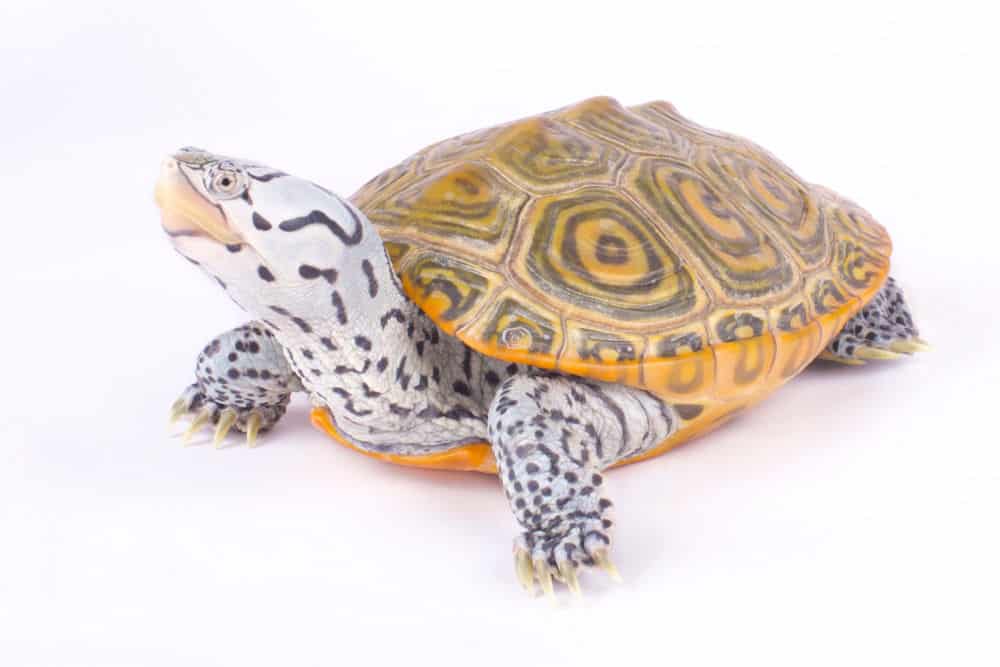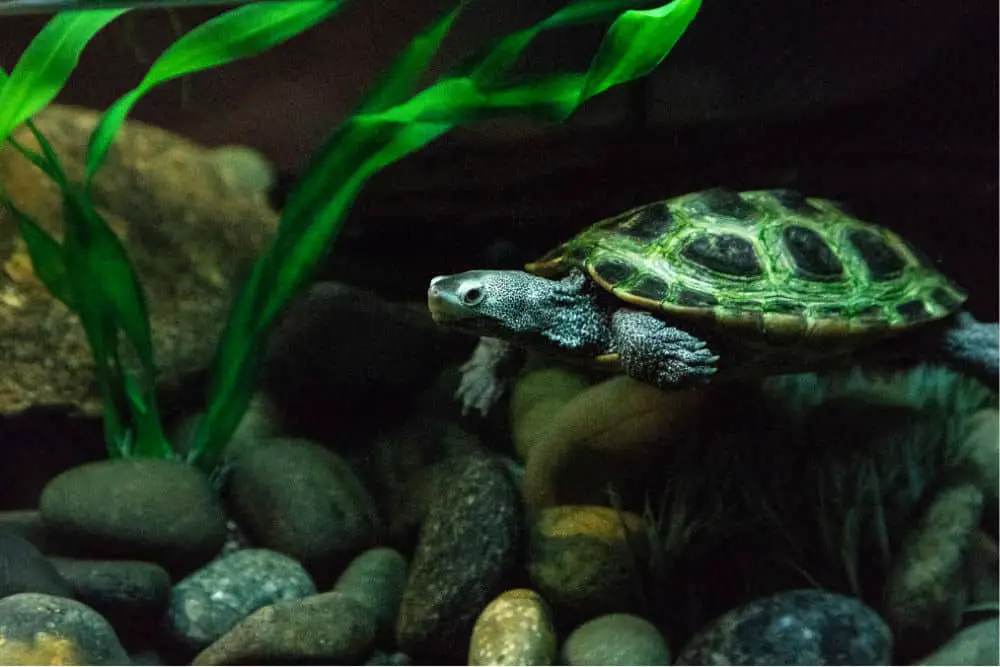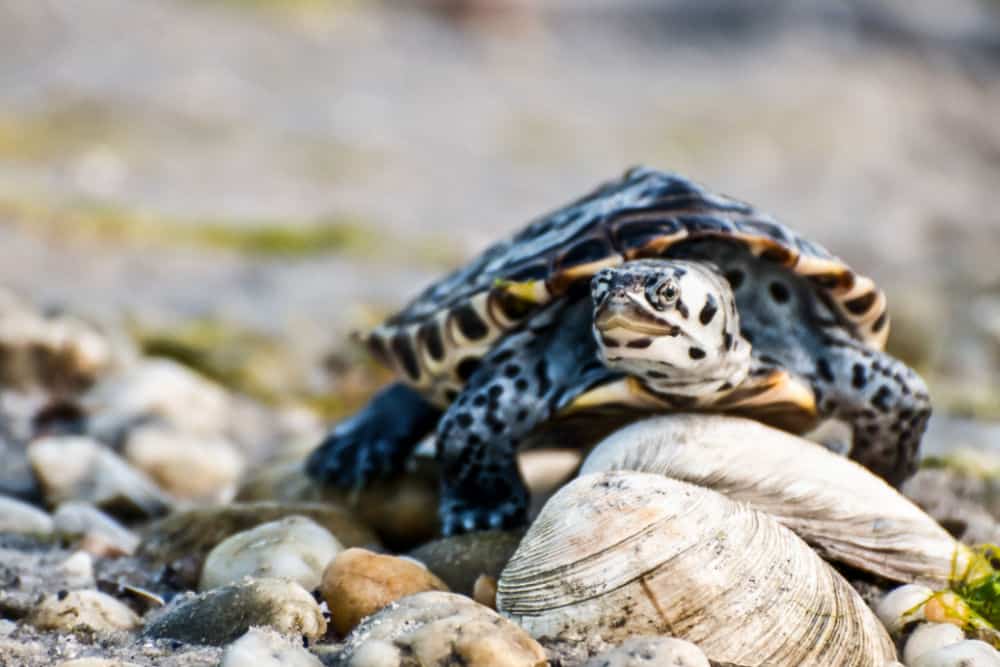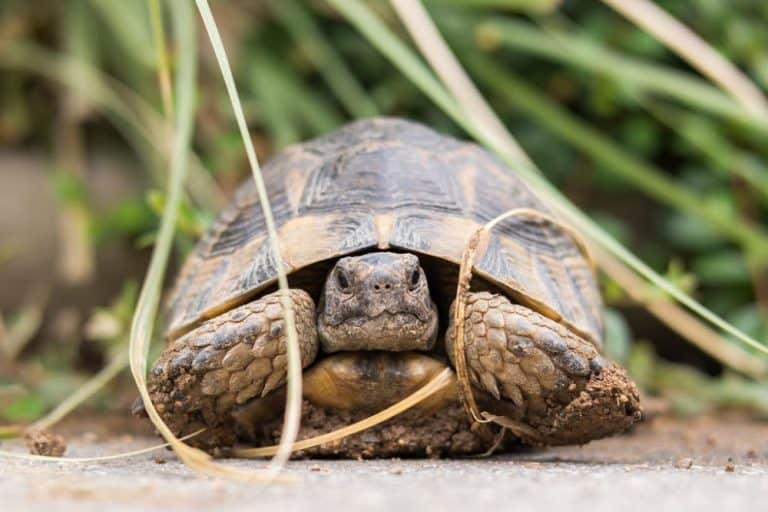Diamondback Terrapin Care Sheet: Diet, Habitat, & More
Diamondback terrapins, or Malaclemys terrapin, are aquatic turtles that can be found along the United States east coast. You can find diamondback terrapins from Texas to Massachusetts, usually in the brackish waters of salt marshes, lagoons, or mangroves.
While diamondback terrapins are not easy to care for, you can study their behavior, give them the right housing and care, and know when they’re sick. Knowing all of these can help you ensure that your pet diamondback terrapins are healthy and happy.
But that’s easier said and done. Here’s a rundown of what you should know, do, and remember when you’re caring for a diamondback terrapin. You will know what and how to feed them, breed them, how to get the proper housing for them, and the challenges of having one as a pet, among others.
Facts About the Diamondback Terrapins
If you have just decided to get a diamondback terrapin as a pet, congratulations. Terrapins are very interesting. Case in point, they differ from other turtles because they don’t like freshwater in the wild. What are the things that you should know about them?
Seven Species of Diamondback Terrapins
According to John Davenport at the University Marine Biological Station Millport, terrapins take their names from the diamond patterns on their carapace or the top of their shells. Their colors can range from dull dark brown to black to yellow and cream.

There are seven different subspecies of the diamondback terrapin, according to where they are found:
- Malaclemys terrapin terrapin, whose territory stretch from Cape Hatteras to Cape Cod, are also called the northern race. Photos and descriptions for this subspecies are found here.
- Malaclemys terrapin centrata thrive in the same area as the northern race, but their habitat extends through Florida. What do these subspecies look like? Check it out here.
- Malaclemys terrapin tequesta are also known as the Florida east coast terrapin. Here’s how they look…
- Malaclemys terrapin rhizophora are found in the mangroves of Florida. Photos and descriptions for these subspecies are found here.
- Malaclemys terrapin macrospilota are found in the southern part of Florida’s coast. These are probably the prettiest terrapins out there, and here is the proof.
- Malaclemys terrapin pileata, also called the Mississippi diamondback, can be found in the waters spanning eastern Louisiana to the Florida Panhandle. Here’s how they look.
- Malaclemys terrapin littoralis, or the Texas diamondback, can be spotted from Louisiana to Corpus Christi, Texas. Photos and descriptions for these subspecies are found here.
Where can you find them in the wild? Researchers from Ohio University and Oregon State University tracked the movements of diamondback terrapins and found that adult females tend to go into deeper waters than adult males and juveniles. They also discovered that the bigger turtles were more inclined to spend time in deeper waters than the smaller ones.

How to Tell a Female Diamondback Terrapin From a Male
Diamondback terrapins are highly sexually dimorphic, which means that the males and females often have distinct characteristics, making it easy to tell them apart.
According to this study, male terrapins have narrower and smaller heads. They also have darker markings on their upper shells or carapace.
What’s more, they have bigger keels, and their vents are closer to the margin of their carapace. Females, on the other hand, have narrow and short tails. Their vents are below an overhanging upper shell.
How Diamondback Terrapins Endure the Brackish Water
Researchers J. Davenport and E-A. Macedo found that while diamondback terrapins live in estuaries and salt marshes, they don’t drink water with high salt content. They can be very creative in finding and drinking even the smallest amount of freshwater.
They can collect rainwater, and they react to ground vibrations that can signal that it’s raining. If you give them fresh water, they can get rehydrated in less than 15 minutes.
Other Facts About Diamondback Terrapins That You Should Know
There are some interesting things that you should know about these aquatic turtles:
- They have muscular legs and big webbed feet that allow them to survive in harsh environments as well as strong currents and tidal changes.
- They secrete tears that have high salt content.
- Male terrapins can grow up to 5.5 inches (13.97 centimeters) in length, while females can reach up to 11 inches (27.9 centimeters).
- The International Union for Conservation of Nature Red List of Threatened Species lists terrapins as vulnerable.
- There are laws against the harvesting and catching of terrapins. For instance, New Jersey has made it illegal to harvest and hunt terrapins, while Maryland banned the commercial harvest of these turtles in 2007.
Caring for Diamondback Terrapins
Now that you have a better understanding of how diamondback terrapins live in the wild, you can take better care of them as pets. And while terrapins have several subspecies, it wouldn’t matter when you raise them as pets.
Housing
The first thing that you should figure out when you start to care for diamondback terrapins at home is where to put them. You can keep them inside the house or find an excellent spot in your yard to house your terrapins.
This site, however, recommends outdoor housing for your terrapins. While you can keep terrapins indoors, it is recommended that you keep them outside where you can set up a bigger housing for your turtles. These medium-sized turtles can grow a lot, especially the females, so it is best to give them enough space for when they get bigger.
Outdoor setups will also reduce the need for you to keep a very large tank inside the house. However, if you are going to care for terrapins indoors, prepare a tank with at least 60 gallons. This will allow you to give your terrapins a lot of water to swim in.
What’s more, terrapins are messy eaters. They often leave scraps of their food floating in the water, which gets dirty and murky real quick. This happens even when you have excellent filtration systems. So you can just imagine the disadvantage of having to clean the tank inside the house.
Terrapins also like big basking areas. Being aquatic turtles, terrapins benefit a lot from drying out. Allowing them to come out of the water will help prevent shell rot. Plus, basking sites are easy to create: you can use river or slate rocks, barks, and other materials.
Having a basking area outdoors means that your pets get to benefit from natural sunlight. Indoors, you will need a heat lamp to keep your terrapins healthy. The light from the sun or the heat lamp will supply your pets with the necessary vitamins and will help them synthesize calcium.
One downside of keeping your terrapins outside is that they have several predators that you need to guard them against, including several species of reptiles, fish, birds, and mammals. Some of the most common predators are raccoons, skunks, and foxes. Hatchlings are also often snatched by herons, crows, or gulls.
Pros of KeepingYour Terrapins Outdoors
- You have more space for a bigger tank, so you can give them more water to swim in
- Better basking area with natural sunlight
- Allows your terrapins to have a separate eating area outside of the water
Cons of Keeping Your Terrapins Outdoors
- More maintenance required
- Open to predators
What Are the Equipment That You Need?
Apart from the tank, here are the things that you should have when you care for a diamondback terrapin:
- Filter – Diamondback terrapins are voracious eaters, and they often take a bite out of their food and neglect the rest, leaving it to sink to the bottom of the tank. Needless to say, the water can get dirty real quick, so filtration is an absolute must.
- Filter sponges – The filter sponges will need to be cleaned once every four days. Be sure to replace them every three months.
- A dry dock – Make sure that you have a floating island or a concrete block that they can bask on inside your tank.
- Basking light – To simulate sunlight, you should have a basking light above the dry dock.
- Heater – Diamondback terrapins require specific water temperatures. Hatchlings for one need warmer water at 28° to 29° Celsius (82.4° to 84.2° Fahrenheit) while adults will be just fine at temperatures ranging from 21° to 26° Celsius (69.8° to 78.8° Fahrenheit).
- A Reptile UVB light – Ultraviolet B is very important in the growth and hardening of your terrapin’s shell. You should place the UVB light inside the tank because it cannot penetrate through glass. Replace the bulb every six months.
What’s more, you should take juvenile diamondback terrapins out in the sun. Natural sunlight will help their shells grow faster and harder.
Freshwater or Brackish Water?
Unlike most turtle species, terrapins can survive in full saltwater. Other turtles tend to avoid salt water and can only survive by not drinking or eating anything. Diamond terrapins love salty water in the wild.
Diamondback terrapins thrive in brackish or salinated water, so the most logical thing to do when you care for them at home is to house them in slightly salty water. However, some people do not like using brackish water for their aquarium set up. They don’t know how to maintain the salinity, or they have freshwater fishes that they’d like to house together with their diamondback terrapins.
Fortunately, according to this Spruce Pets guide, you can keep them in freshwater provided that you monitor their health. Any sign of sickness, and you should switch to salty water.
What Is Brackish Water Anyway?
Brackish water represents the middle ground in salinity levels: it has more salt than freshwater but not as much salt as seawater.
The Department of Water and Environmental Regulation of the Government of West Australia shares the difference between freshwater, brackish water, and seawater by salinity.
| Salinity(in milligrams of salt per liter) | |
| Fresh | Less than 500 |
| Marginal | 500 – 1,000 |
| Brackish | 1,000 – 2,000 |
| Saline | 2,000 – 10,000 |
| Highly saline | 10,000 – 35,000 |
| Brine | More than 35,000 |
How Do You Prepare Brackish Water?
To prepare brackish water, you will need a slightly alkaline hard water with a pH level of 7.2 to 8.5. It should also have a specific gravity of around 1.005. By contrast, freshwater has a specific gravity of 1.000, while saltwater has a specific gravity of 1.024.
What’s more, temperatures should be anywhere from 23° to 29° Celsius (73.4° to 84.2° Fahrenheit), so you will need a heater just in case the water cools down. You can test the water’s pH levels and temperature using devices like the SunGrow Digital pH and TDS Meter Set.
Keeping the right pH level and specific gravity in mind, you can start creating a brackish water aquarium.
- Fill the bucket with fresh water, but leave just enough space at the top to accommodate the salt that you are going to put in.
- Use a heater to make the temperature of the water the same as the temperature in your aquarium water.
- Add the salt into the bucket and stir well. Wait 20 minutes to allow the salt to dissolve and then stir the water again.
Remember, do not add salt directly to your tank water. Doing so will damage your plants and may harm the animals in the tank.
- Slowly add the salt and water mixture into your aquarium water while monitoring the specific gravity.
Here’s a video with reminders on how to start a brackish water aquarium:
So, Is It Freshwater or Brackish Water?
What’s the consensus in the brackish vs. freshwater debate? Slightly saline water is always the best choice for raising diamondback terrapins. But there are instances when you can use freshwater.
According to Diamondback Terrapin World, captive-born hatchlings can be raised in freshwater, and they will be just fine. However, you should be quick to spot skin problems or shell rot. If these conditions occur, then use brackish water because the salt helps prevent shell rot.
If you have just caught an adult diamondback terrapin, then you should house it in brackish water. Not doing so will cause shell rot in no time.
Filtration
Excellent water quality helps keep your terrapins healthy. Filtration keeps the water clean. It removes both nitrites and ammonia as it aerates the water so your pets can breathe easier.
The best bet you have is biological filtration, which uses beneficial bacteria to break down nitrate and ammonia. The result is a less harmful compound nitrate. You can use an under gravel filter, sand filter, or something like the MarineLand Penguin 350 BIO-Wheel Power Filter.
Another filtration system uses mechanical filters such as floss or sponge to trap the waste particles. Using something like the UPETTOOLS Aquarium Biochemical Sponge Filter can help clean the water.
You will need to clean the sponge on this one to make sure that it works efficiently. You should also know that this kind of filtration is never enough and is often used with other filtration systems. It only removes floating waste, but the nitrite, nitrate, or ammonia will still be in your terrapin’s water.
You can also use chemical filtration, which removes colors and odors from the water. Activated carbon filters are most widely used for this. If you’re using salty water, you might want to try those with protein skimmers to filtrate the water.

What to Feed Your Pet Diamondback Terrapins
In the wild, diamondback terrapins eat other sea animals, but they also ingest plants in small quantities. Because terrapins have strong jaws, they can crush shells and plates. As such, mussels, sea snails, worms, insects, and carrions are staple fare for these turtles.
Their favorite food might not be accessible for you, though. So how do you feed your diamondback terrapins?
Feeding Hatchlings
It’s never too early to introduce commercial turtle food that is specially formulated for hatchlings, such as the Exo Terra Hatchling Aquatic Turtle Food and the Zoo Med Natural Aquatic Turtle Food – Hatchling Formula.
Hatchlings prefer fresh seafood, krill, or live food. But if they get used to these treats, they might not give commercial pellets a chance, and that could be a problem if you can’t get a steady supply of fresh food for your turtles.
If a hatchling doesn’t eat, try to make the water a bit warmer to around 29.4° Celsius (85° Fahrenheit). Hatchlings often become less active if the water is too cold.
Meal Time for Juveniles
With juveniles or those more than three inches (7.62 centimeters) but are not yet of breeding size, you should do an every-other-day feeding. Give them all the food they can eat within 15 minutes. After such time, you should scoop out the remaining food from the water.
Juveniles tend to eat everything you feed them. Some say that this voracious appetite will help them grow faster, but it may also cause problems with improperly formed shells.
Suggested products include a mixture of commercial turtle feed such as:
- Omega One Turtle Sticks
- Mazuri Aquatic Turtle Diet
- Tetra Tetrafauna Pro ReptoMin Juvenile Turtle Formula Sticks
Feeding the Adults
Adults may hibernate and come out when spring comes. During this time, you should feed them with a mix of commercial feeds every day. However, you should gradually lessen the amount of food you give them and the frequency until you can feed them once every two days.
If you have caught an adult diamondback terrapin, you should know that it will refuse to eat commercial pellets. If this is the case, you can try feeding it small fish and seafood. You can buy frozen prawns at the supermarket and then just defrost it in hot water, cut to appropriate sizes, and feed your terrapin.
Aside from shrimp, here are your other alternatives, according to this page:
- Raw meat. Uncooked chicken, beef, or pork can be a treat for fussy adult terrapins.
- Live insects and worms. You can hand-feed your terrapin some bloodworms, tubifex, crickets, and mealworms that you buy from pet shops.
- Finely chopped vegetables and fruits. Terrapins will also love watercress, pear, strawberries, and leafy vegetables.
- Other seafood. Aside from prawns, you can also feed your terrapins oily fish such as mackerel, tuna, and sardines.
But remember, while muscled meats and dried shrimp are okay, don’t rely on these as a staple food for your terrapins. These items can lead to nutritional deficiencies in these turtles in the long run.
Force Feeding
When a terrapin is too weak or too sick to eat, you can force feed it as a last resort. However, be sure to check with your vet first.
You can use a metal nail file to pry open its mouth. Work from the rear part of the jaw and insert the nail file. Once in, you should slide the nail file forward to let the terrapin open and close its mouth.
Hold the jaw open by inserting a plastic cap from a ballpen. Carefully put the food inside the terrapin’s mouth and slide it to the back of its mouth.
When force-feeding, use shrimp. Your terrapin should be able to eat two full pieces when you force-feed it.
Other Tips to Remember When Feeding Your Diamondback Terrapin
When it comes to feeding your terrapins, there are some things that you should know:
- Younger terrapins need to eat frequently. You should feed hatchlings daily, while adult terrapins can get by eating two or three times a week.
- Terrapins are known to be messy eaters. To minimize the mess, only give them the food that they can eat in a short period of time.
- Find a commercial feed with calcium as your terrapins will need it for the healthy development of their shells.
- Even if your terrapins eat commercial food, you should introduce variety, as well. The Bairbre O’Malley Veterinary Hospital recommends turtle pellets, small live fish, earthworms, mealworms, liver, and chopped green vegetables to help juvenile terrapins get vitamin A and calcium. Meanwhile, adults should have 70 percent vegetables and 30 percent turtle pellets.
- Always cut your terrapins’ food to small chunks that are easy for them to eat to prevent choking.
- Terrapins eat only in water.
What to Look for in Commercial Terrapin Feed
- Made with fresh ingredients
- Fortified with the right types and levels of vitamins and minerals such as calcium for their shells
- Floating to make it easier for your terrapins to spot
- No artificial preservatives or colorings
- Preferably insoluble so that it doesn’t add to the pollution in the water
Breeding
According to the National Aquarium, diamondback terrapins mate in the early spring. They usually nest through the middle of summer. The bigger females can lay clutches with anywhere from four to 23 eggs. Mother terrapins can lay two or three clutches every year.
This video shows a terrapin laying eggs.
According to Terrapins.co.uk, when in captivity, the terrapin’s maturity is determined by length, not age. Mature males measure four inches (10.16 centimeters) or longer, while females mature when they reach six inches (15.2 centimeters)—Terrapins mate in the water at the start of spring. The females lay eggs from April to July.
Incubation is done in vermiculite, a mineral that is humid, at temperatures ranging from 80° to 85° Fahrenheit (26.7° to 29.4° Celsius). The temperature during incubation influences the sex of the hatchlings, with higher temperatures bringing forth female terrapins. After two months of incubation, the hatchlings will emerge from the eggs.
How do you encourage copulation between terrapins?
- Give them an artificial shower
- Change the brightness of the artificial lighting
- Separate them for months
- Separate them when they hibernate
- Take them out into the sun during summer
Changing their diets can also influence successful mating.
Hibernation
Some subspecies of diamondback terrapins, such as the northern race, hibernate through the fall and winter months. But southern species do not. When it comes to hibernation, you should be aware of your terrapin’s health. It should have enough stored fat to go through the months of inactivity.
Diseases
When you care for a terrapin, the single most prevalent disease you should look out for is shell rot and other fungal and bacterial infections. The worst kind of shell rot is called a septicemic cutaneous ulcerative disease or SCUD, which is characterized by:
- Ulcers
- Loss of digits and claws
- Paralysis
- Hemorrhage
While the Citrobacter freundii causes SCUD, there is another type of shell rot caused by the Baneckea chitinovora bacteria. This kind of shell rot will cause shredded plates, the slimy and brownish membrane covering the skin, and raw ulcers. You can fight shell rot by applying povidone-iodine or silver sulfadiazine, among other antiseptic and antimicrobial treatments.
Aside from skin infections, terrapins can sometimes suffer from internal diseases that might cause:
- Lost appetite
- Lost balance in the water
- Swollen and stiff joints
- Internal bleeding
- Puffy eyes
When you see these symptoms, be sure to consult a veterinarian. You should also watch out for respiratory diseases, which happen when the water is colder than ideal. Foamy nasal and oral discharges often manifest respiratory issues. You can raise the temperature of the water to treat minor respiratory problems.
Conclusion
There are reliable and legal turtle breeders that sell diamondback terrapins. Baby hatchlings are better suited for freshwater tanks than adults you catch in the wild.
Knowing how to house terrapins, what to feed them, the warning signs of disease, and understanding their behavior can help you spend a long time with these cute and docile pets.
After all, they’re known to live for up to four decades out in the wild.



I appreciate the information, as a retired wildlife rescue and control operator, I never thought that I would be caring for a hatchling Mississippi Diamondback Terrapin, along with 2 rescue cats!. The information provided has been a big help, my little hatchling seems to be to doing fine in a freshwater aquarium with the proper lighting and diet, friendly and active with a healthy appetite and just completing it’s first molt!! There is a unique story behind this rescue!